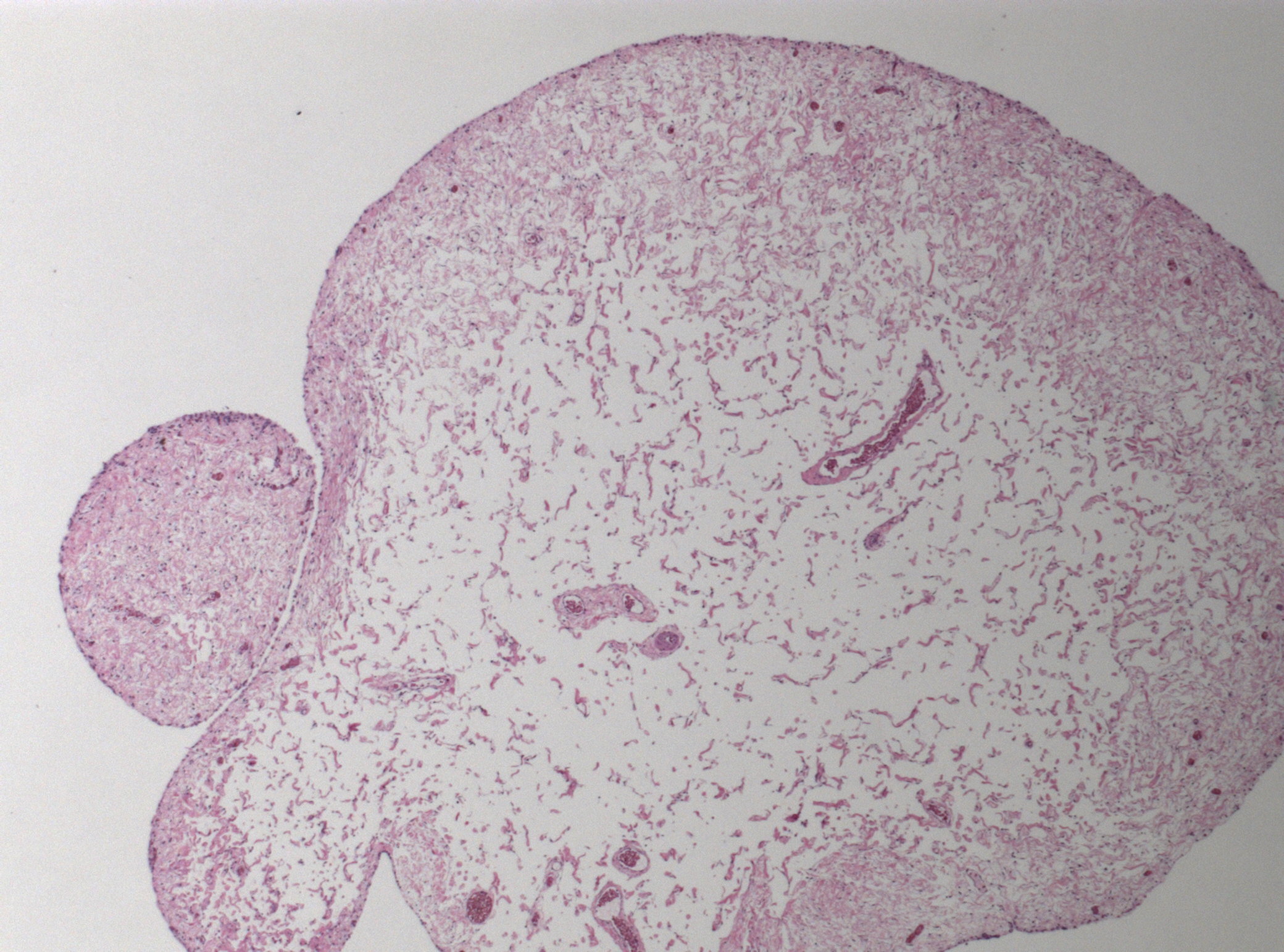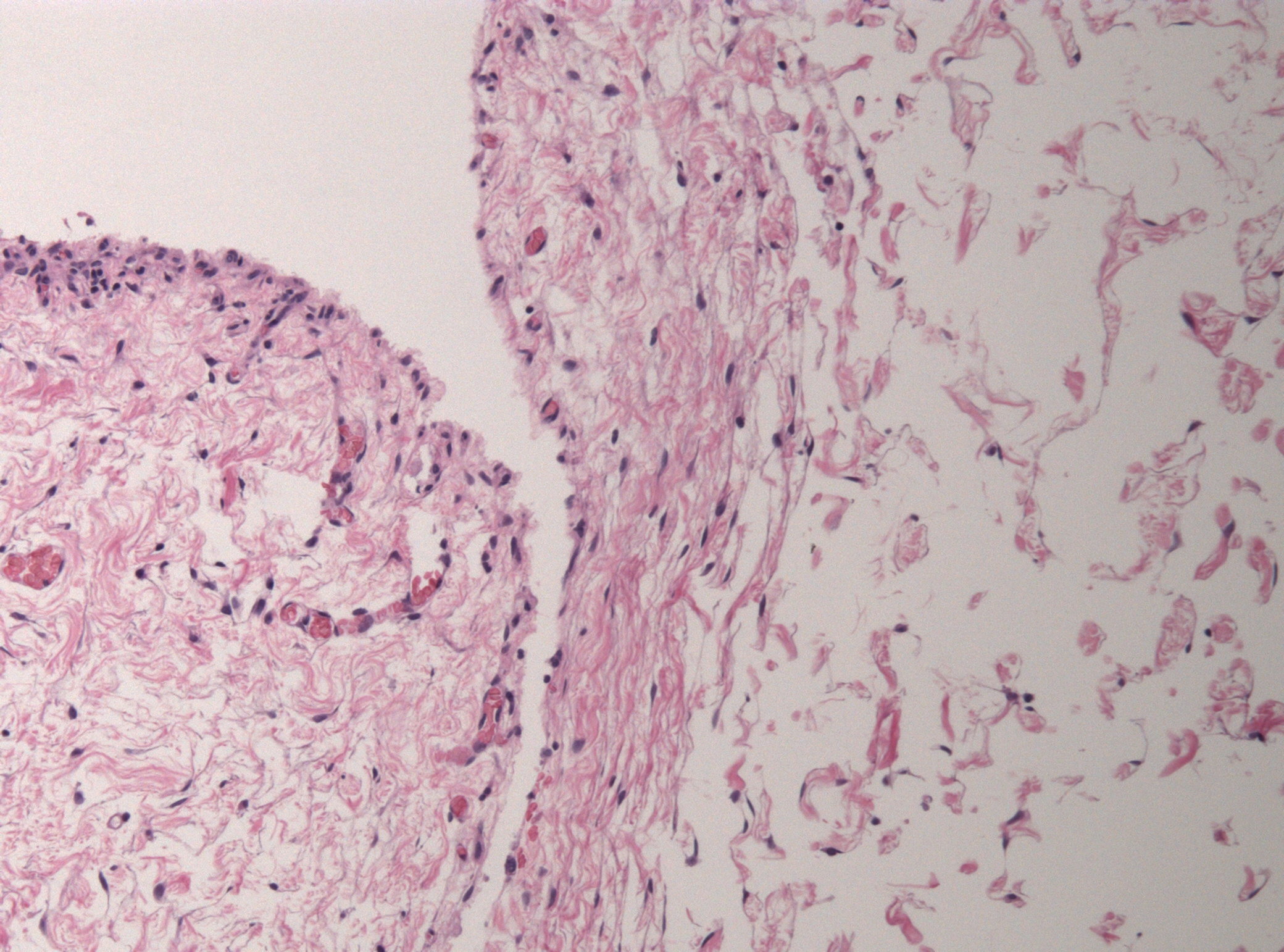Arnold-Chiari malformation pathophysiology: Difference between revisions
No edit summary |
No edit summary |
||
| (2 intermediate revisions by the same user not shown) | |||
| Line 4: | Line 4: | ||
{{CMG}}; {{AE}} {{Fs}} | {{CMG}}; {{AE}} {{Fs}} | ||
==Overview== | ==Overview== | ||
The exact pathogenesis of Arnol-Chiari malformation is not fully understood but It is thought that Arnol-Chiari malformation is the result of bone developmental abnormalities or mesodermal growth and differentiation abnormalities. Genes involved in the pathogenesis of Arnold-Chiari malformation include PAX1, PAX2, PAX3, PAX6, FGF2, TBX6, HOX gene, Noggin gene, and EFNB1. | The exact [[pathogenesis]] of Arnol-Chiari malformation is not fully understood but It is thought that Arnol-Chiari malformation is the result of [[bone]] [[developmental]] [[abnormalities]] or [[Mesoderm|mesodermal]] [[growth]] and differentiation [[abnormalities]]. [[Gene|Genes]] involved in the [[pathogenesis]] of Arnold-Chiari malformation include [[PAX1]], [[PAX2]], [[PAX3]], [[PAX6]], [[FGF2]], [[TBX6]], HOX [[gene]], [[Noggin (protein)|Noggin]] gene, and EFNB1. Conditions associated with Arnold-Chiari malformation include [[hydrocephalus]], [[Syringomyelia|syringomyelias]],[[Tethered spinal cord syndrome]], [[Neurofibromatosis type I|neurofibromatosis type 1]], [[Noonan syndrome]], [[Pierre Robin syndrome|Pierre Robin sequence]], [[Klippel-Feil syndrome]], [[Albright hereditary osteodystrophy]], x-linked aqueductal stenosis, [[Goldenhar syndrome]], [[Williams syndrome]], [[Shprintzen-Golberg craniosynostosis|Shprintzen- goldberg syndrome]], [[achondroplasia]], familial osteosclerosis, [[velocardiofacial syndrome]], and [[connective tissue disorders]]. | ||
==Pathophysiology== | ==Pathophysiology== | ||
===Pathogenesis=== | ===Pathogenesis=== | ||
* The exact pathogenesis of Arnol-Chiari malformation is not fully understood but It is thought that Arnol-Chiari malformation is the result of cascade of anomalies that lead to: | * The exact [[pathogenesis]] of Arnol-Chiari malformation is not fully understood but It is thought that Arnol-Chiari malformation is the result of cascade of anomalies that lead to: | ||
**Bone developmental abnormalities | **[[Bone]] [[developmental]] [[abnormalities]] | ||
**Mesodermal growth and differentiation abnormalities | **[[Mesoderm|Mesodermal]] [[growth]] and differentiation [[abnormalities]] | ||
* These anomalies can be congenital as a result of developmental error or acquired. | * These [[Anomaly|anomalies]] can be [[congenital]] as a result of developmental error or acquired. | ||
* All the potential causes of Chiari malformation will lead to posterior cranial fossa abnormalities and subsequently herniation of cerebellar and/or other structures from foramen magnum. | * All the potential causes of Chiari malformation will lead to [[posterior cranial fossa]] [[abnormalities]] and subsequently [[herniation]] of [[cerebellar]] and/or other structures from [[foramen magnum]]. | ||
==Genetics== | ==Genetics== | ||
* Genes involved in the pathogenesis of Arnold-Chiari malformation include:<ref name="SchankerWalcott2011">{{cite journal|last1=Schanker|first1=Benjamin D.|last2=Walcott|first2=Brian P.|last3=Nahed|first3=Brian V.|last4=Kahle|first4=Kristopher T.|last5=Li|first5=Yan Michael|last6=Coumans|first6=Jean-Valery C. E.|title=Familial Chiari malformation: case series|journal=Neurosurgical Focus|volume=31|issue=3|year=2011|pages=E1|issn=1092-0684|doi=10.3171/2011.6.FOCUS11104}}</ref> | *[[Gene|Genes]] involved in the [[pathogenesis]] of Arnold-Chiari malformation include:<ref name="SchankerWalcott2011">{{cite journal|last1=Schanker|first1=Benjamin D.|last2=Walcott|first2=Brian P.|last3=Nahed|first3=Brian V.|last4=Kahle|first4=Kristopher T.|last5=Li|first5=Yan Michael|last6=Coumans|first6=Jean-Valery C. E.|title=Familial Chiari malformation: case series|journal=Neurosurgical Focus|volume=31|issue=3|year=2011|pages=E1|issn=1092-0684|doi=10.3171/2011.6.FOCUS11104}}</ref> | ||
**PAX1 | **[[PAX1]] | ||
**PAX2 | **[[PAX2]] | ||
**PAX3 | **[[PAX3]] | ||
**PAX6 | **[[PAX6]] | ||
**FGF2 | **[[FGF2]] | ||
**TBX6 | **[[TBX6]] | ||
**HOX gene | **HOX gene | ||
**Noggin gene | **[[Noggin (protein)|Noggin]] gene | ||
**EFNB1 | **EFNB1 | ||
* There are many findings emphasizing on genetic basic of Chiari malformation including: | * There are many findings emphasizing on [[genetic]] basic of Chiari malformation including: | ||
** Many studies described higher prevalence of Chiari malformation among mono zygote twins or between family members. | ** Many studies described higher [[prevalence]] of Chiari malformation among [[Monozygotic twins|mono zygote twins]] or between family members. | ||
**There are some evidence showing autosomal dominant/ recessive transmission. | **There are some evidence showing [[autosomal dominant]]/ recessive transmission. | ||
**There are many genetic conditions that have association with Chiari malformation. | **There are many [[genetic]] conditions that have association with Chiari malformation. | ||
==Associated Conditions== | ==Associated Conditions== | ||
Conditions associated with Arnold-Chiari malformation include:<ref name="urlNeuropathology For Medical Students">{{cite web|url=http://www.pathology.vcu.edu/WirSelfInst/neuro_medStudents/devdis.html |title=Neuropathology For Medical Students |work= |accessdate=}}</ref><ref name="Milhorat-2007">{{Cite journal|author=Milhorat TH, Bolognese PA, Nishikawa M, McDonnell NB, Francomano CA |title=Syndrome of occipitoatlantoaxial hypermobility, cranial settling, and chiari malformation type I in patients with hereditary disorders of connective tissue |journal=[[Journal of Neurosurgery|Journal of Neurosurgery: Spine]] |volume=7 |issue=6 |pages=601–9 |year=2007 |month=December |pmid=18074684 |doi=10.3171/SPI-07/12/601 |url=http://thejns.org/doi/full/10.3171/SPI-07/12/601}}</ref><ref name="pmid11598609">{{cite journal |vauthors=Holder-Espinasse M, Abadie V, Cormier-Daire V, Beyler C, Manach Y, Munnich A, Lyonnet S, Couly G, Amiel J |title=Pierre Robin sequence: a series of 117 consecutive cases |journal=J. Pediatr. |volume=139 |issue=4 |pages=588–90 |date=October 2001 |pmid=11598609 |doi=10.1067/mpd.2001.117784 |url=}}</ref><ref name="pmid15087107">{{cite journal |vauthors=Tubbs RS, Rutledge SL, Kosentka A, Bartolucci AA, Oakes WJ |title=Chiari I malformation and neurofibromatosis type 1 |journal=Pediatr. Neurol. |volume=30 |issue=4 |pages=278–80 |date=April 2004 |pmid=15087107 |doi=10.1016/j.pediatrneurol.2003.09.013 |url=}}</ref><ref name="SchankerWalcott20112">{{cite journal|last1=Schanker|first1=Benjamin D.|last2=Walcott|first2=Brian P.|last3=Nahed|first3=Brian V.|last4=Kahle|first4=Kristopher T.|last5=Li|first5=Yan Michael|last6=Coumans|first6=Jean-Valery C. E.|title=Familial Chiari malformation: case series|journal=Neurosurgical Focus|volume=31|issue=3|year=2011|pages=E1|issn=1092-0684|doi=10.3171/2011.6.FOCUS11104}}</ref> | Conditions associated with Arnold-Chiari malformation include:<ref name="urlNeuropathology For Medical Students">{{cite web|url=http://www.pathology.vcu.edu/WirSelfInst/neuro_medStudents/devdis.html |title=Neuropathology For Medical Students |work= |accessdate=}}</ref><ref name="Milhorat-2007">{{Cite journal|author=Milhorat TH, Bolognese PA, Nishikawa M, McDonnell NB, Francomano CA |title=Syndrome of occipitoatlantoaxial hypermobility, cranial settling, and chiari malformation type I in patients with hereditary disorders of connective tissue |journal=[[Journal of Neurosurgery|Journal of Neurosurgery: Spine]] |volume=7 |issue=6 |pages=601–9 |year=2007 |month=December |pmid=18074684 |doi=10.3171/SPI-07/12/601 |url=http://thejns.org/doi/full/10.3171/SPI-07/12/601}}</ref><ref name="pmid11598609">{{cite journal |vauthors=Holder-Espinasse M, Abadie V, Cormier-Daire V, Beyler C, Manach Y, Munnich A, Lyonnet S, Couly G, Amiel J |title=Pierre Robin sequence: a series of 117 consecutive cases |journal=J. Pediatr. |volume=139 |issue=4 |pages=588–90 |date=October 2001 |pmid=11598609 |doi=10.1067/mpd.2001.117784 |url=}}</ref><ref name="pmid15087107">{{cite journal |vauthors=Tubbs RS, Rutledge SL, Kosentka A, Bartolucci AA, Oakes WJ |title=Chiari I malformation and neurofibromatosis type 1 |journal=Pediatr. Neurol. |volume=30 |issue=4 |pages=278–80 |date=April 2004 |pmid=15087107 |doi=10.1016/j.pediatrneurol.2003.09.013 |url=}}</ref><ref name="SchankerWalcott20112">{{cite journal|last1=Schanker|first1=Benjamin D.|last2=Walcott|first2=Brian P.|last3=Nahed|first3=Brian V.|last4=Kahle|first4=Kristopher T.|last5=Li|first5=Yan Michael|last6=Coumans|first6=Jean-Valery C. E.|title=Familial Chiari malformation: case series|journal=Neurosurgical Focus|volume=31|issue=3|year=2011|pages=E1|issn=1092-0684|doi=10.3171/2011.6.FOCUS11104}}</ref><ref name="pmid14564218">{{cite journal |vauthors=Holder-Espinasse M, Winter RM |title=Type 1 Arnold-Chiari malformation and Noonan syndrome. A new diagnostic feature? |journal=Clin. Dysmorphol. |volume=12 |issue=4 |pages=275 |date=October 2003 |pmid=14564218 |doi=10.1097/01.mcd.0000081505.97834.0a |url=}}</ref> | ||
*[[Hydrocephalus]] | *[[Hydrocephalus]] | ||
*[[Syringomyelia]]<nowiki/>s | *[[Syringomyelia]]<nowiki/>s | ||
*[[Tethered spinal cord syndrome]] | *[[Tethered spinal cord syndrome]] | ||
| Line 41: | Line 41: | ||
*[[Noonan syndrome]] | *[[Noonan syndrome]] | ||
*[[Pierre Robin syndrome|Pierre Robin sequence]] | *[[Pierre Robin syndrome|Pierre Robin sequence]] | ||
*Klippel-Feil syndrome | *[[Klippel-Feil syndrome]] | ||
*Albright hereditary osteodystrophy | *[[Albright hereditary osteodystrophy]] | ||
*X-linked aqueductal stenosis | *X-linked aqueductal stenosis | ||
*Goldenhar syndrome | *[[Goldenhar syndrome]] | ||
*Williams syndrome | *[[Williams syndrome]] | ||
*Shprintzen- goldberg syndrome | *[[Shprintzen-Golberg craniosynostosis|Shprintzen- goldberg syndrome]] | ||
*Achondroplasia | *[[Achondroplasia]] | ||
*Familial osteosclerosis | *Familial osteosclerosis | ||
*Velocardiofacial syndrome | *[[Velocardiofacial syndrome]] | ||
*[[Connective tissue disease|Connective tissue disorder]]<nowiki/>s such as: | *[[Connective tissue disease|Connective tissue disorder]]<nowiki/>s such as: | ||
**[[Ehlers-Danlos syndrome]] | **[[Ehlers-Danlos syndrome]] | ||
| Line 58: | Line 58: | ||
==Microscopic Pathology== | ==Microscopic Pathology== | ||
On microscopic pathology, there is enlaged, dysplastic / reactive fibrous tissue and choroid plexus in a Chiari II malformation | On microscopic pathology, there is enlaged, dysplastic / reactive [[fibrous tissue]] and [[choroid plexus]] in a Chiari II malformation. | ||
. | |||
[[File:Hypertrophic plexus chiari II low mag.jpg|500px|none|thumb|https://librepathology.org/wiki/File:Hypertrophic_plexus_chiari_II_low_mag.jpg]] | [[File:Hypertrophic plexus chiari II low mag.jpg|500px|none|thumb|https://librepathology.org/wiki/File:Hypertrophic_plexus_chiari_II_low_mag.jpg]] | ||
Latest revision as of 21:16, 28 September 2019
|
Arnold-Chiari malformation Microchapters |
|
Differentiating Arnold-Chiari malformation from other Diseases |
|---|
|
Diagnosis |
|
Treatment |
|
Case Studies |
|
Arnold-Chiari malformation pathophysiology On the Web |
|
American Roentgen Ray Society Images of Arnold-Chiari malformation pathophysiology |
|
Risk calculators and risk factors for Arnold-Chiari malformation pathophysiology |
Editor-In-Chief: C. Michael Gibson, M.S., M.D. [1]; Associate Editor(s)-in-Chief: Fahimeh Shojaei, M.D.
Overview
The exact pathogenesis of Arnol-Chiari malformation is not fully understood but It is thought that Arnol-Chiari malformation is the result of bone developmental abnormalities or mesodermal growth and differentiation abnormalities. Genes involved in the pathogenesis of Arnold-Chiari malformation include PAX1, PAX2, PAX3, PAX6, FGF2, TBX6, HOX gene, Noggin gene, and EFNB1. Conditions associated with Arnold-Chiari malformation include hydrocephalus, syringomyelias,Tethered spinal cord syndrome, neurofibromatosis type 1, Noonan syndrome, Pierre Robin sequence, Klippel-Feil syndrome, Albright hereditary osteodystrophy, x-linked aqueductal stenosis, Goldenhar syndrome, Williams syndrome, Shprintzen- goldberg syndrome, achondroplasia, familial osteosclerosis, velocardiofacial syndrome, and connective tissue disorders.
Pathophysiology
Pathogenesis
- The exact pathogenesis of Arnol-Chiari malformation is not fully understood but It is thought that Arnol-Chiari malformation is the result of cascade of anomalies that lead to:
- Bone developmental abnormalities
- Mesodermal growth and differentiation abnormalities
- These anomalies can be congenital as a result of developmental error or acquired.
- All the potential causes of Chiari malformation will lead to posterior cranial fossa abnormalities and subsequently herniation of cerebellar and/or other structures from foramen magnum.
Genetics
- Genes involved in the pathogenesis of Arnold-Chiari malformation include:[1]
- There are many findings emphasizing on genetic basic of Chiari malformation including:
- Many studies described higher prevalence of Chiari malformation among mono zygote twins or between family members.
- There are some evidence showing autosomal dominant/ recessive transmission.
- There are many genetic conditions that have association with Chiari malformation.
Associated Conditions
Conditions associated with Arnold-Chiari malformation include:[2][3][4][5][6][7]
- Hydrocephalus
- Syringomyelias
- Tethered spinal cord syndrome
- Neurofibromatosis type 1
- Noonan syndrome
- Pierre Robin sequence
- Klippel-Feil syndrome
- Albright hereditary osteodystrophy
- X-linked aqueductal stenosis
- Goldenhar syndrome
- Williams syndrome
- Shprintzen- goldberg syndrome
- Achondroplasia
- Familial osteosclerosis
- Velocardiofacial syndrome
- Connective tissue disorders such as:
Gross Pathology
On gross pathology, there is no characteristic finding of Chiari malfromation.
Microscopic Pathology
On microscopic pathology, there is enlaged, dysplastic / reactive fibrous tissue and choroid plexus in a Chiari II malformation.


References
- ↑ Schanker, Benjamin D.; Walcott, Brian P.; Nahed, Brian V.; Kahle, Kristopher T.; Li, Yan Michael; Coumans, Jean-Valery C. E. (2011). "Familial Chiari malformation: case series". Neurosurgical Focus. 31 (3): E1. doi:10.3171/2011.6.FOCUS11104. ISSN 1092-0684.
- ↑ "Neuropathology For Medical Students".
- ↑ Milhorat TH, Bolognese PA, Nishikawa M, McDonnell NB, Francomano CA (2007). "Syndrome of occipitoatlantoaxial hypermobility, cranial settling, and chiari malformation type I in patients with hereditary disorders of connective tissue". Journal of Neurosurgery: Spine. 7 (6): 601–9. doi:10.3171/SPI-07/12/601. PMID 18074684. Unknown parameter
|month=ignored (help) - ↑ Holder-Espinasse M, Abadie V, Cormier-Daire V, Beyler C, Manach Y, Munnich A, Lyonnet S, Couly G, Amiel J (October 2001). "Pierre Robin sequence: a series of 117 consecutive cases". J. Pediatr. 139 (4): 588–90. doi:10.1067/mpd.2001.117784. PMID 11598609.
- ↑ Tubbs RS, Rutledge SL, Kosentka A, Bartolucci AA, Oakes WJ (April 2004). "Chiari I malformation and neurofibromatosis type 1". Pediatr. Neurol. 30 (4): 278–80. doi:10.1016/j.pediatrneurol.2003.09.013. PMID 15087107.
- ↑ Schanker, Benjamin D.; Walcott, Brian P.; Nahed, Brian V.; Kahle, Kristopher T.; Li, Yan Michael; Coumans, Jean-Valery C. E. (2011). "Familial Chiari malformation: case series". Neurosurgical Focus. 31 (3): E1. doi:10.3171/2011.6.FOCUS11104. ISSN 1092-0684.
- ↑ Holder-Espinasse M, Winter RM (October 2003). "Type 1 Arnold-Chiari malformation and Noonan syndrome. A new diagnostic feature?". Clin. Dysmorphol. 12 (4): 275. doi:10.1097/01.mcd.0000081505.97834.0a. PMID 14564218.